Biological seed treatment
Learn the importance of knowing the role of biological tools for seed treatment against initial diseases in soybean and corn
With the possibility of spacing of 45, 50 and 76 centimeters, the Maestro Duo, from HORSCH, is a precision seeder-fertilizer, with great autonomy and which facilitates movement between plots measuring 3,10 meters wide in transport mode.
After the excellent opportunity to test the HORSCH seeder, model Maestro Evolution 36.50, in the field for the May 2021 edition of Revista Cultivar Máquinas, in Barreiras (BA), now it was time to discover and test the Maestro Duo 36.50 model, in Terenos , in Mato Grosso do Sul. Unlike the Maestro Evolution model, which only deposits seeds, the Duo model, as its name suggests, is a machine that simultaneously deposits seeds and fertilizers.
The Maestro Duo is a seeder-fertilizer produced in Brazil since 2020, when it was launched and presented to the public in 24, 30 and 36 row versions. The 24-row version can be purchased by HORSCH customers with row spacings of 45cm, 50cm or 76cm. The offer at 76cm spacing is recent, meeting the needs of cotton and corn producers. The 30 and 36 row versions are only offered to producers in 45cm and 50cm spacings, commonly adopted in soybean and corn crops. Therefore, at the time of purchase, the customer must inform the desired spacing, and it is no longer possible to make changes to the machine.
As proof of the machine's acceptance by the market, there are numerous units sold and working in different regions of the country. Furthermore, as it is a national product, it has the possibility of official financing, as it has the Finame code.
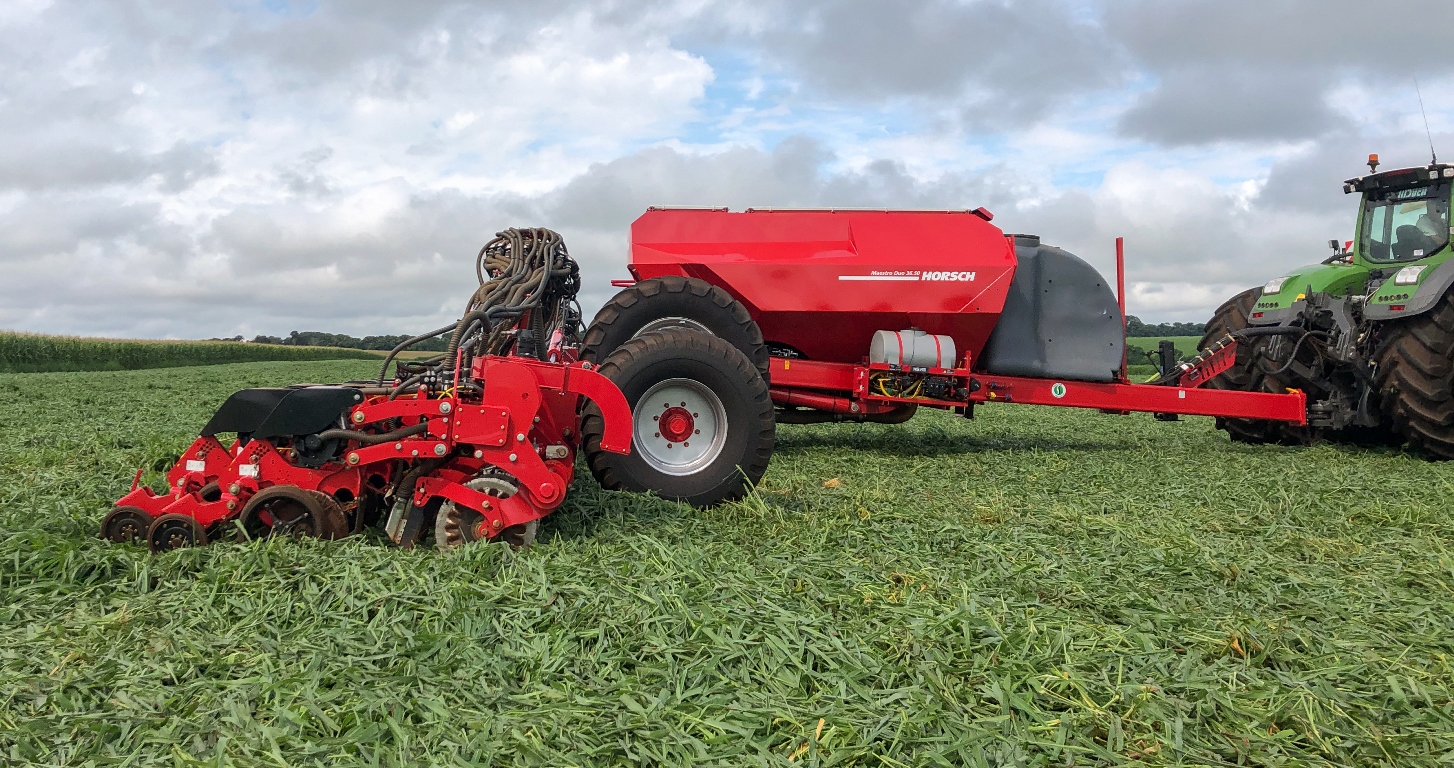
As the machine we tested is a large piece of equipment, made up of 36 rows spaced 50cm apart, totaling a working width of 18 meters, the project included a system for articulating the sowing and fertilizing bars, making the machine self-transportable, or In other words, it allows travel on roads or transportation in trucks. This required the manufacturer to develop complex engineering work, which made it possible to reduce the width of the machine to 3,10 meters, when fully closed.
To maintain greater working autonomy, the tank is sized for a total volume of nine thousand liters, seven thousand liters for fertilizer and two thousand liters for seeds. To facilitate access during the supply operation, the tank was designed to receive the fertilizer at the front and the seeds at the back, separated by independent gates. The reservoirs have two large lids that favor supply, with the size of the fertilizer nozzle being larger when compared to the seed nozzle. The entrances have a protection grid that prevents the passage of hardened fertilizer or contaminants that may come with the seeds, avoiding compromising the integrity of the seeder's internal mechanisms. The lids have latches and shock absorbers to aid opening and closing, as well as a rubber seal that ensures the correct functioning of the pneumatic system. At the bottom of the tank there is a hydraulically driven agitator mechanism, which is activated during maneuvers, moving the fertilizer to avoid compaction and subsequent caking.
The machine is joined to the tractor by means of a robust header, the same as the one fitted to the Evolution model, highlighting the safety chain with hook, which serves to protect against disengagement, preventing possible accidents.
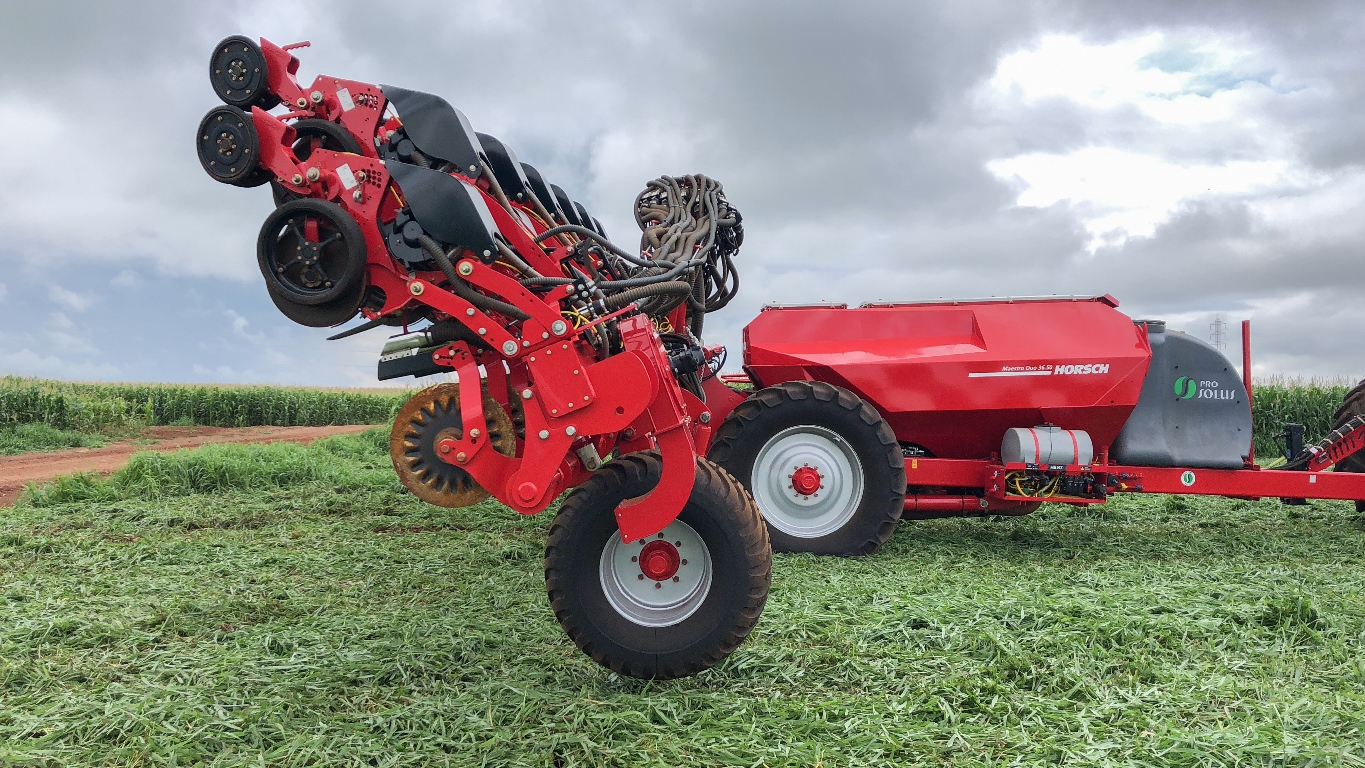
Due to the hydraulic system's flow requirement of approximately 190 liters per minute, four remote control valves (VCRs) are required. A VCR for activating the functions, one for activating the vacuum turbine with flow control, one for activating the blower (seeds) with flow control, and a VCR for activating the blower (fertilizer) with flow control, which allows the operation of seed dosers using negative pressure. The importance of a free return must be highlighted, because the system is dependent on hydraulic flow and not just pressure. In addition to the hydraulic connections, two electrically conductive cables are needed to supply the Extra-Power, for the seeding lines, which have electrically driven mechanisms, as we will describe later.
The connection between the planting bars and the machine structure is called bock, which is supported on the chassis. The chassis structure is coupled to the tractor's drawbar and supported on radial tires in specification 520/85 R42, and the wheel gauge can vary from 3,10m to 3,70m. Access to the machine platform is via a ladder with five steps, with a non-slip surface, the last one being movable and supported by handholds and handrails that facilitate stabilization and guarantee worker safety.
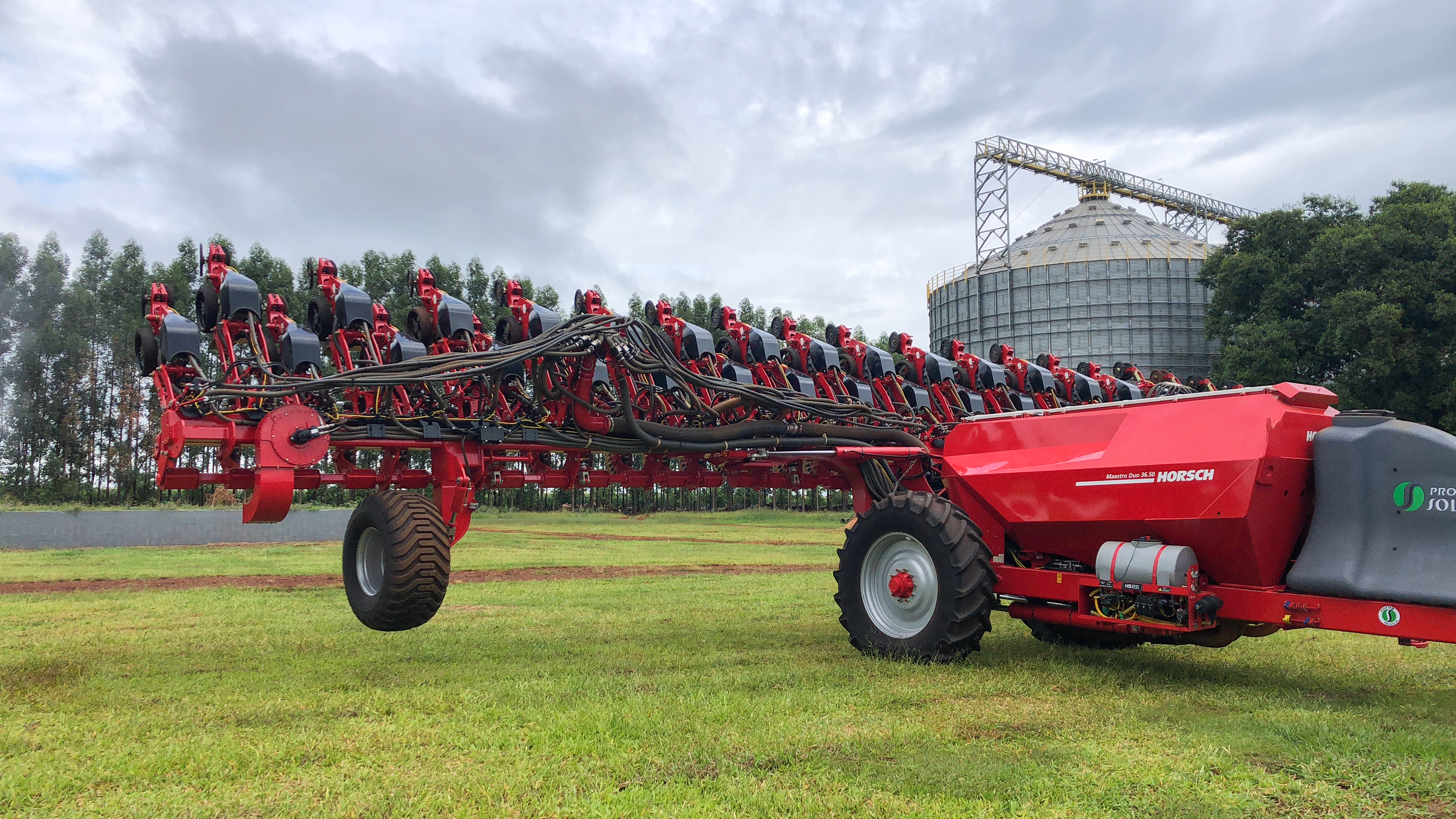
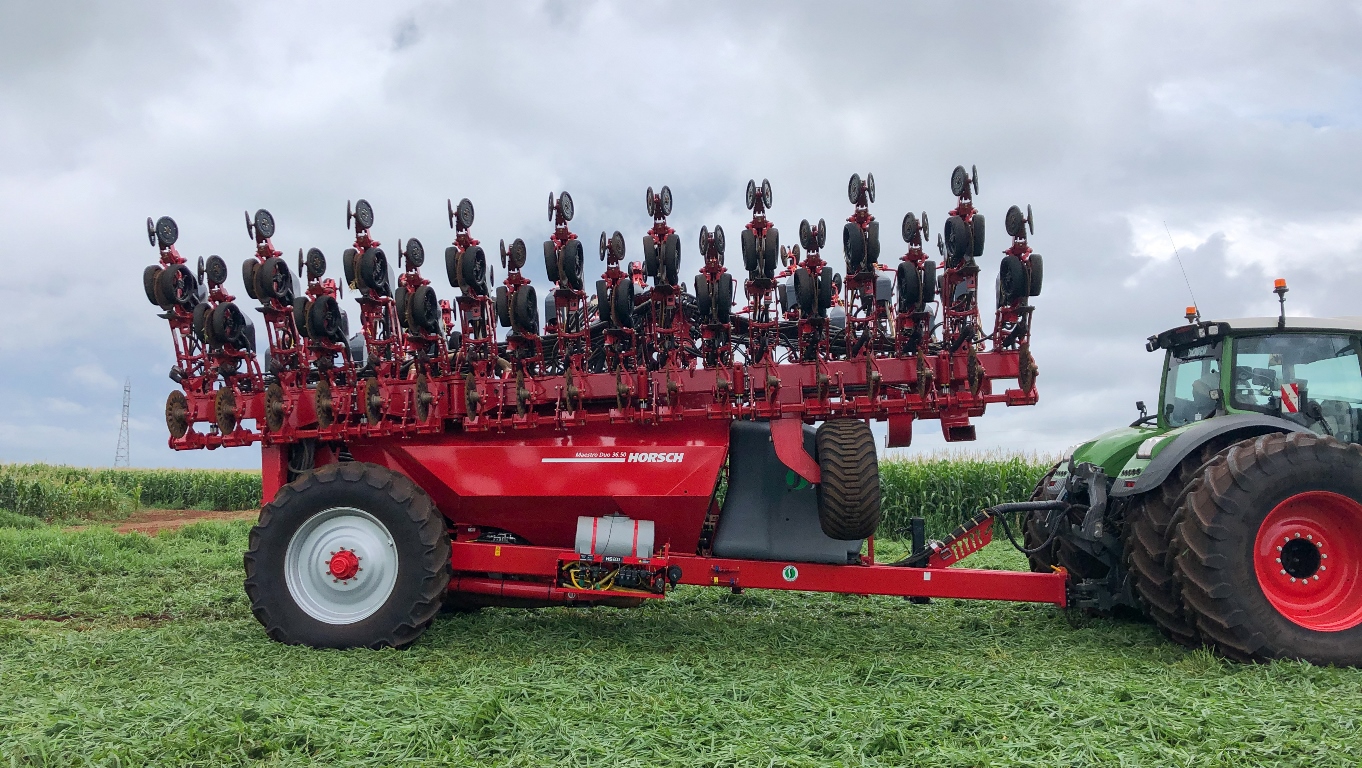
This equipment is truly innovative, as it has a central structure, as previously described, where the seed and fertilizer deposits, hydraulic circuit, wheels, dosers, turbine, toolbox, among other mechanisms are located, having an almost independent a seeding and fertilizing bar, very similar to a sprayer. Due to the long bar length, it is necessary to equalize the groove opening pressure across the entire length of the bar. To make this possible, a weight transfer system was designed from the chassis structure and reservoir through the bock to the bars, which is done by two hydraulic pistons arranged on both sides, and the line pressure system, consisting of hydraulic cylinders that apply a vertical force, ranging from 150kgf to 330kgf in the sowing lines. This entire process occurs through the action of weight transfer mechanisms and the application of complementary force through auxiliary hydraulic cylinders and combined and electronically controlled lever arms, with adjustments being made by the operator directly from inside the tractor cabin, changing the configuration on the HORSCH monitor.
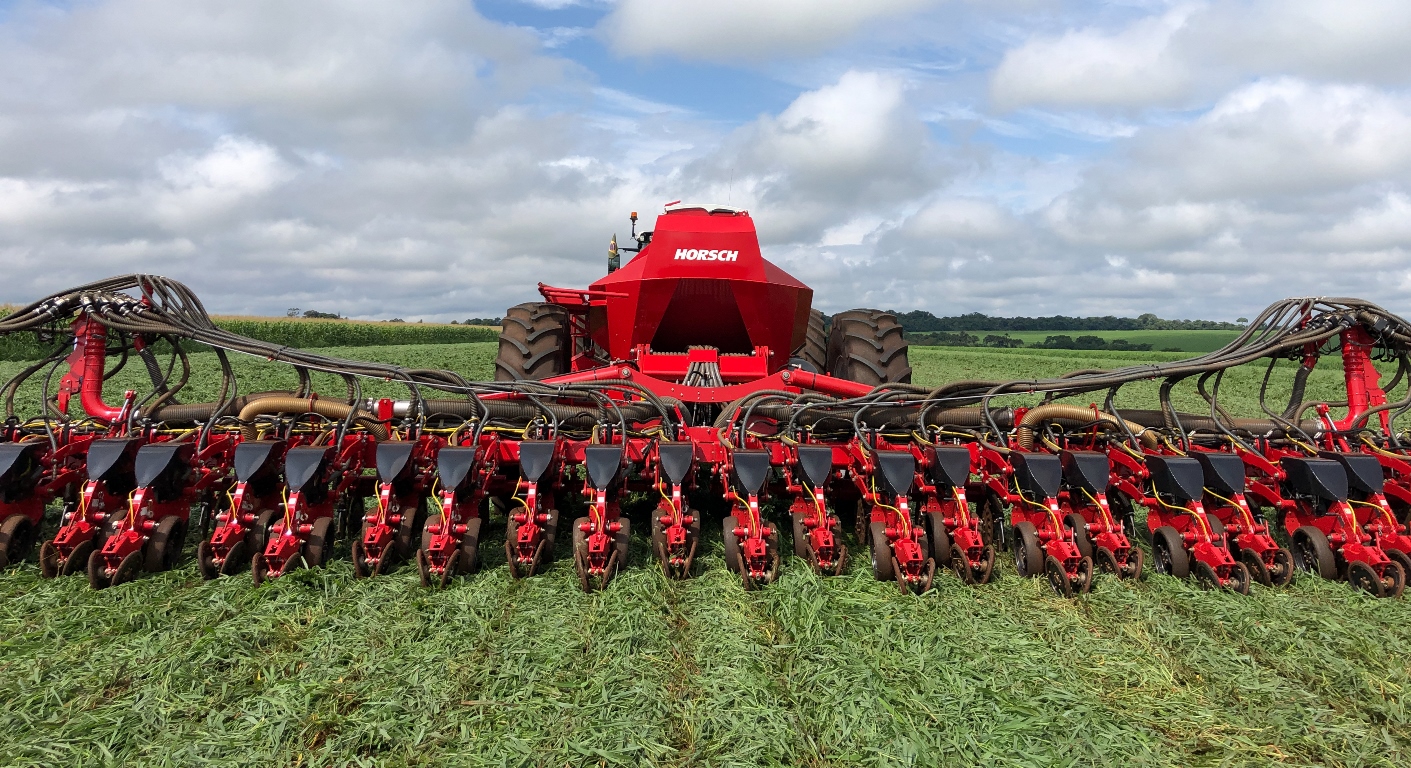
The bar, fixed to the bock, has a pantograph structure, which allows the sowing and fertilization lines to be raised and lowered, maintaining a uniform angle of attack along the entire length of the bar. Furthermore, during work the bar is articulated into four sections, located in the middle and in the central frame, with the central portion being articulated into two other parts.
The bar, made up of the sowing and fertilization lines, is supported on tires with dimensions 550/60-22,5 of high flotation, which expand the contact surface, resulting in a reduction in compaction and a reduction in the formation of tracks. It is worth noting that each of the lines is identified with its respective number, facilitating identification by the operator when the monitor indicates flow obstruction in one of the lines. To collect the bar, for transportation or displacement, the bock's hydraulic pistons lift the frame and, through the action of two auxiliary hydraulic cylinders, retract the bar sections forward, towards the tank.
Fertilizer dosing occurs through a central doser, of the channeled rotor type, positioned at the bottom of the tank and electrically driven. The mass flow from the deposit, after passing through the dosing mechanism, goes via positive air flow to the larger towers, arranged one on each side of the main bar.
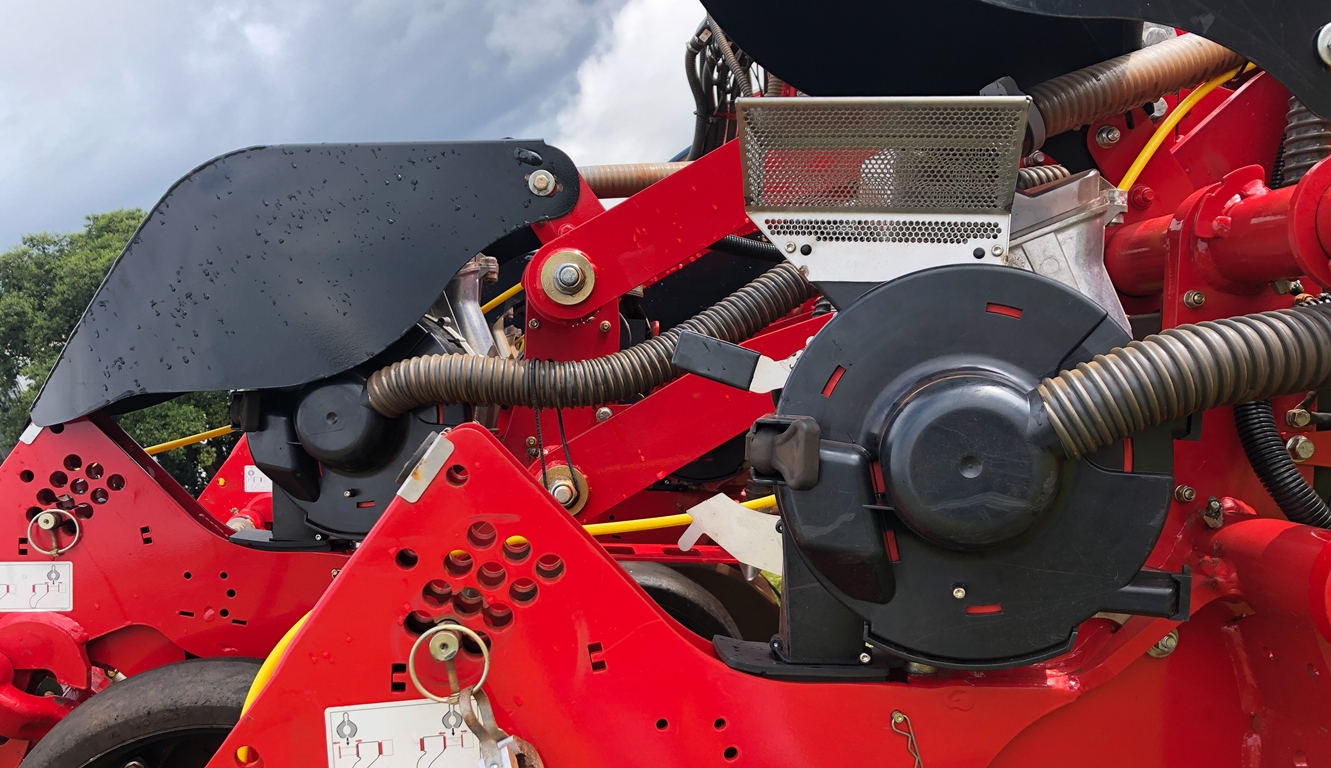
From the larger towers, the fertilizer passes through dividers that route the flow individually to each of the lines, specifically to the distribution rod, made up of a furrower without a tip. Close to the outlet there is a sensor that informs the operator of possible abnormalities in the fertilizer flow.
The seeds move from the reservoir by positive air current to the flow divider, and the seeding lines are supplied using hoses. The air flow produced by the SOD turbine, hydraulically driven, drives the seeds to the HORSCH brand doser, which uses extra power electricity to drive them. It is worth noting that HORSCH is a pioneer in the design of electric dosers and adopts the SOD system, an acronym for the term seed on demand, which means seed dosing on demand. The seeds that reach the dosing mechanism adhere to the pneumatic vertical disc by the action of the vacuum, attaching themselves to the orifice. The place where the disc is inserted is divided into three parts, firstly, the seed entry and vacuum actuation, adhering the seeds; next, the singulator, which acts to eliminate double seeds (singulation), and, finally, the air stream cutting section with negative pressure. Cutting the pressure causes the seed to fall into the conductive tube, sending it to the furrow. The amount of seed inside the doser must be adjusted by opening the gate, which can be regulated on a scale from 0 to 6.
The machine we tested had an option, which consists of a device for placing small seeds on the line. The doser is electrically operated and the seeds from a special 600-liter tank are sent by air current to small towers, positioned on the sowing and fertilization bar. These towers are similar to those used for fertilizer, but smaller, and through pipes, the seeds reach the rooftop output lines. In addition to small seeds, the customer can also use this mechanical subsystem for other granulated products, if they need to be deposited close to the surface.
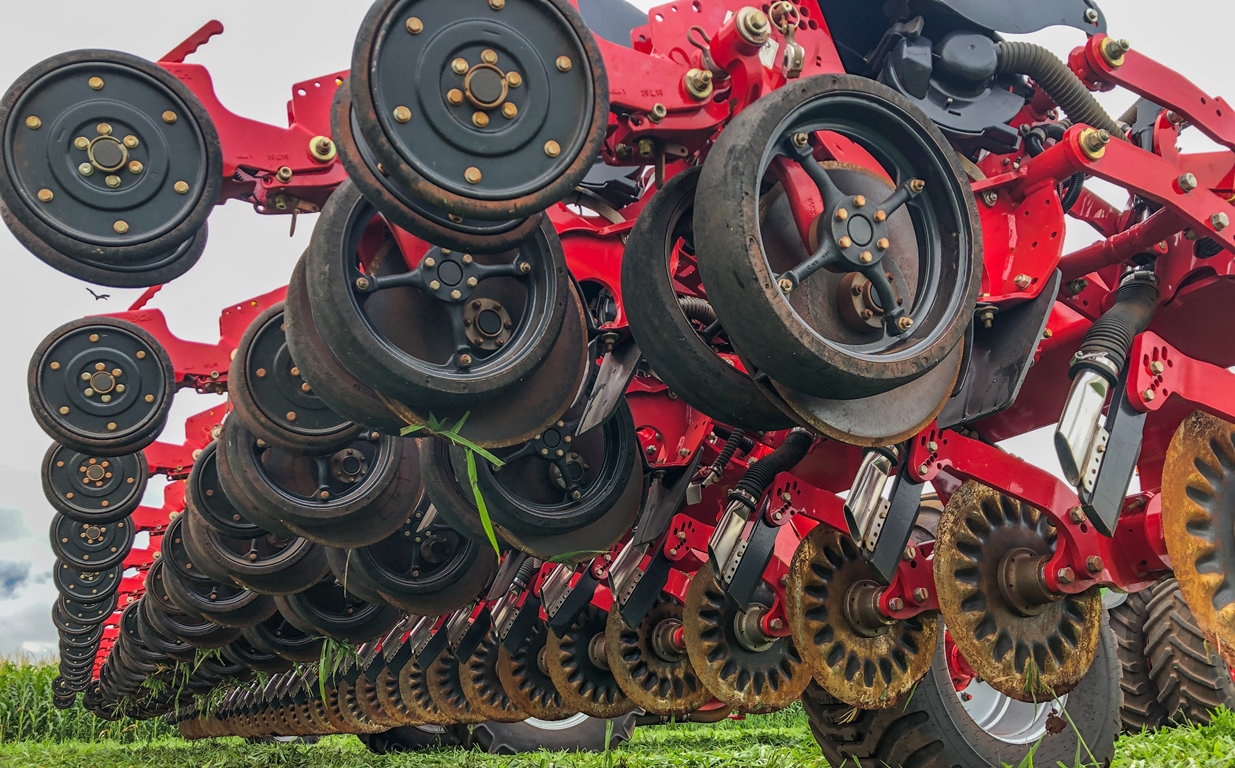
Fixed to the bar by means of a parallelogram and in an aligned manner are the opening, furrow conditioning, fertilizer and seed deposition mechanisms. Individually, each fertilization and sowing line is made up of a sequence of components with different functions. Firstly, we have the straw cutting disc with a diameter of 20 inches, responsible for cutting and separating the straw, reducing the risk of accumulation and clogging in the other components. Depending on the customer's choice, this disc can be smooth or corrugated. We could not forget an important differentiator of this machine, which is the mechanical device for adjusting the angle of attack of the cutting disc, using a hydraulic piston connected to the structure, activated directly on the monitor inside the cabin. Sequentially, on the back of the cutting disc we have the fertilizer distribution rod, equipped with a deflector, which prevents the deposition of soil on the other components, when sowing is carried out in conditions of higher humidity, especially in more clayey soils.
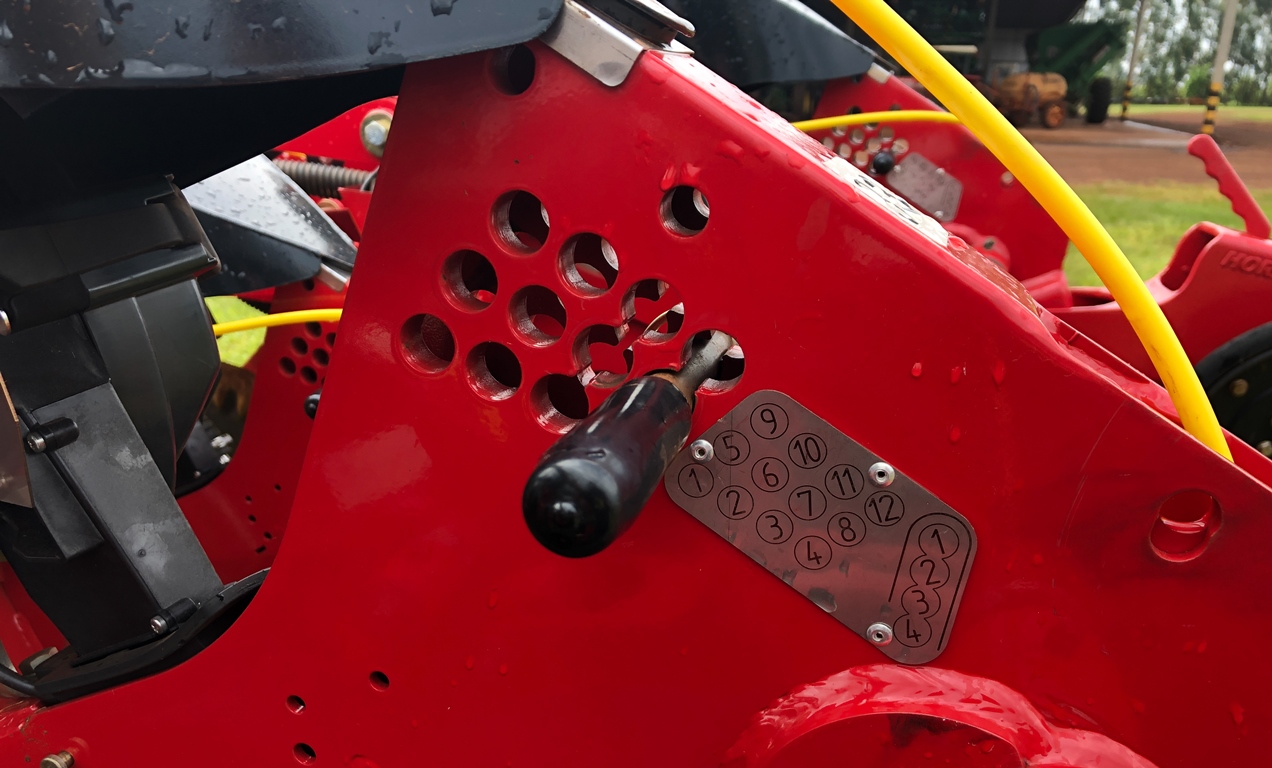
The mechanism that opens the furrow for placing the seeds is of the double disc type, with a diameter of 16 inches. Two depth control wheels are located on the sides of the discs, one on each side, providing centimetric adjustment of the sowing depth, with adjustment carried out by positioning a pin in equidistant holes. Each combined position of the pin and hole represents a 0,6cm variation in depth. The pin in hole 1 starts from a depth of 1,5cm and varies each hole every 0,6cm. Then, the compacting wheels with working angle adjustment come into action, which exert pressure in a targeted manner on the sides of the furrow, ensuring greater contact between the seed and the soil, avoiding the formation of air pockets and loss of moisture. , which directly interferes with the speed of germination and emergence.
Another difference that deserves to be highlighted in this machine is the reduction in lubrication points, with just four, as well as the use of shielded bearings.
For the field test with the HORSCH, Maestro Duo 36.50 model, the team from Revista Cultivar and the Agrotechnology Laboratory of the Agricultural Machinery Testing Center went to Jaraguá Farm, in the municipality of Terenos, in the state of Mato Grosso do Sul. The farm and its operations belong to the WDuch Group, owned by Walter Duch, who manages one of the Duch Group's areas. On this farm, the area is 6.500 hectares, cultivated with soybeans, corn and sorghum, interspersed with millet and brachiaria used as cover crops in a rotation system. Traditionally, it is a livestock farming region, but this activity is not currently practiced on the farm. The machine, owned by the client, was in perfect condition, as it had recently started work on the corn harvest, which has yet to be harvested.
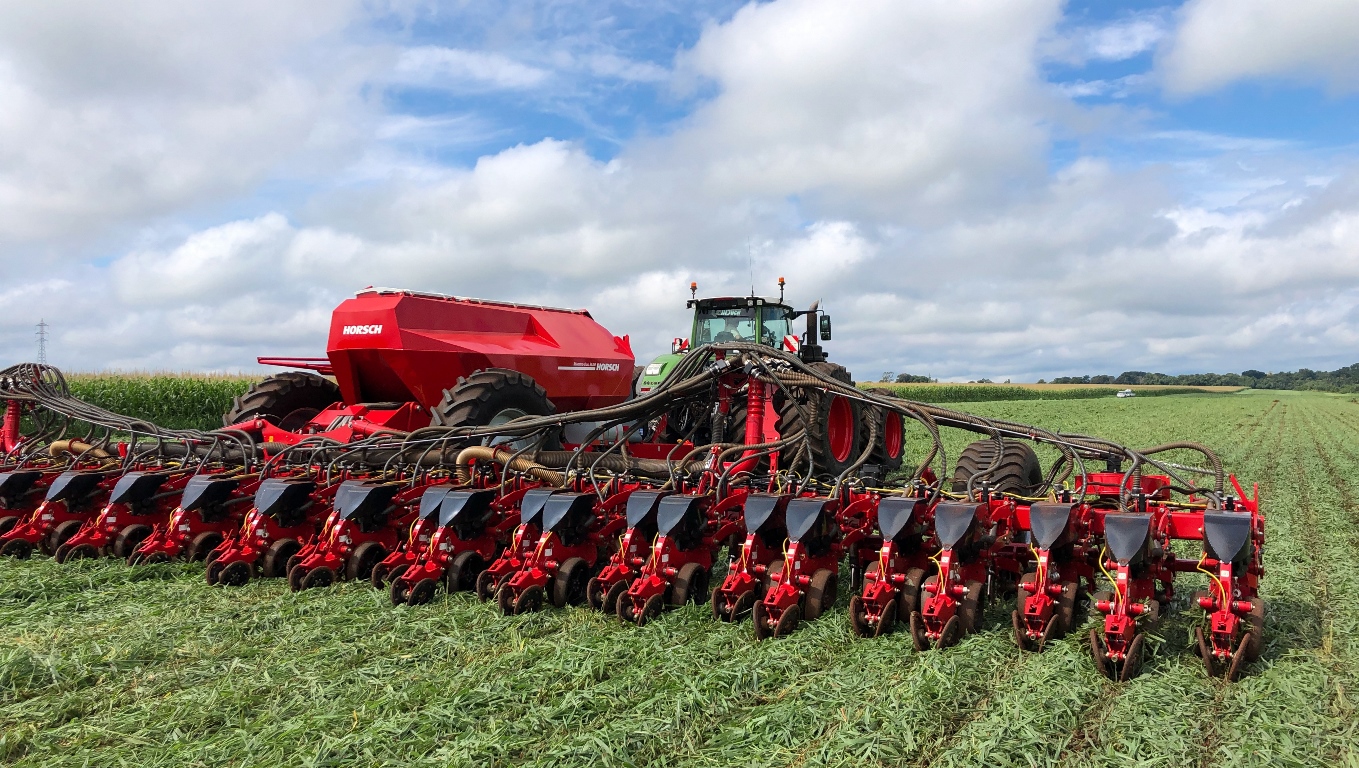
We had the support of Mr. Benhardt Seitz, who is the machine operator, in charge of working on the sowing, and also of the general manager, Fernando Oliveira, who accompanied us throughout and gave us support for the field test.
We work on a rolled brachiaria cover, which will receive soybeans in the next crop. Although last summer's harvest was seriously affected by the lack of rain in the first half of the growing season, some plots produced up to 90 bags of soybeans per hectare. The very fertile soil has a very favorable texture, which also facilitates the mechanization process.
During the sowing and fertilization operation we operate at an average speed of 7km/h with an average vertical force of the lines at 180kgf. At any time, it was possible to view the behavior of the flow per line on the HORSCH monitor and be notified in the event of a flow interruption.
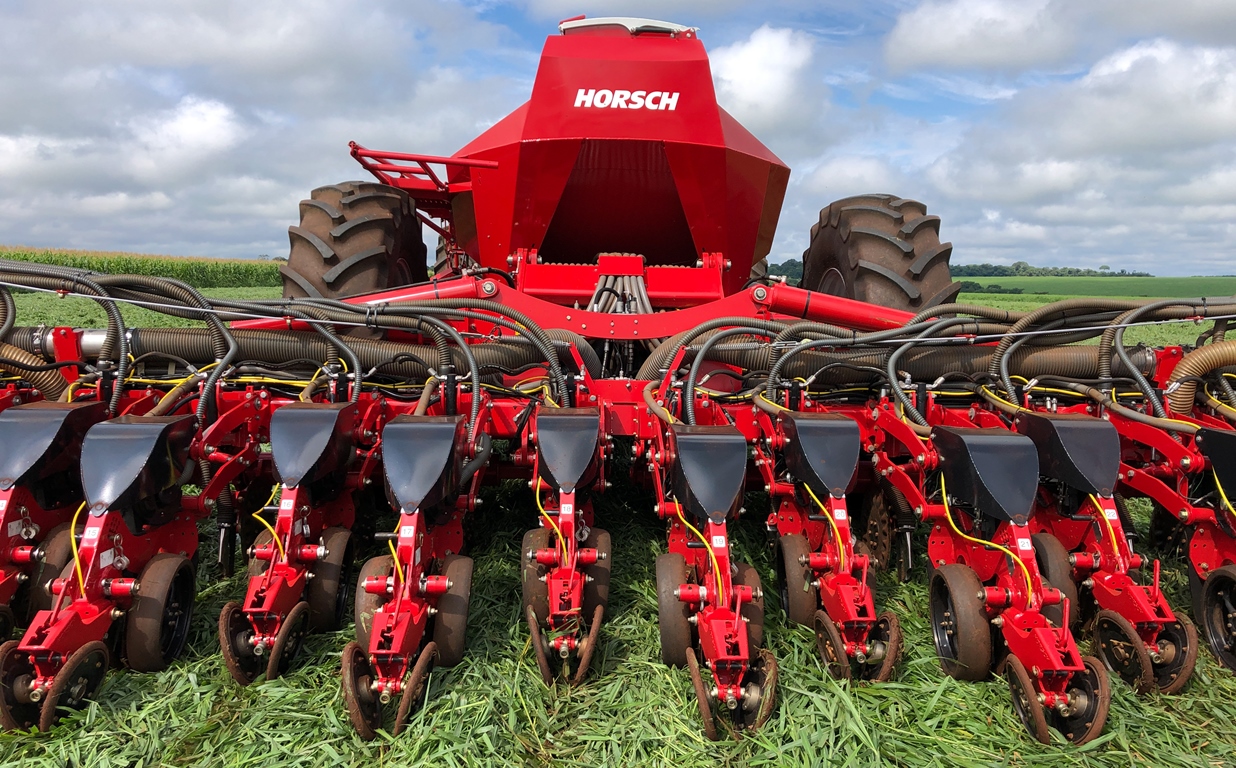
On the part of the manufacturer, once again we had the support of agronomist Samuel Barros, who is a specialist in Product Marketing for the brand and who, in a very efficient way, explained how it worked in detail and provided us with the entire structure and logistics for the test. .
We pulled the HORSCH seeder with the customer's Fendt tractor, model 1046 Vario. This tractor has a six-cylinder engine, 476hp maximum power and CVT transmission. The hydraulic system uses up to two variable flow pumps, reaching 410 liters per minute and up to six remote control valves. In the tractor cabin we had two monitors, the first referring to the tractor's operational behavior and the second dedicated to machine performance information, both positioned on the right side console of the tractor cabin.
We highlight some important points, which we saw and appreciated during the knowledge and field test with the machine. Firstly, to highlight something that we had already seen in two other machines from the brand that we subjected to test drives, which is the industrial quality of the product, highlighted in several points, such as the use of noble materials, such as aluminum and stainless steel, the welding and painting process, the quality and placement of electrical and hydraulic line harnesses.
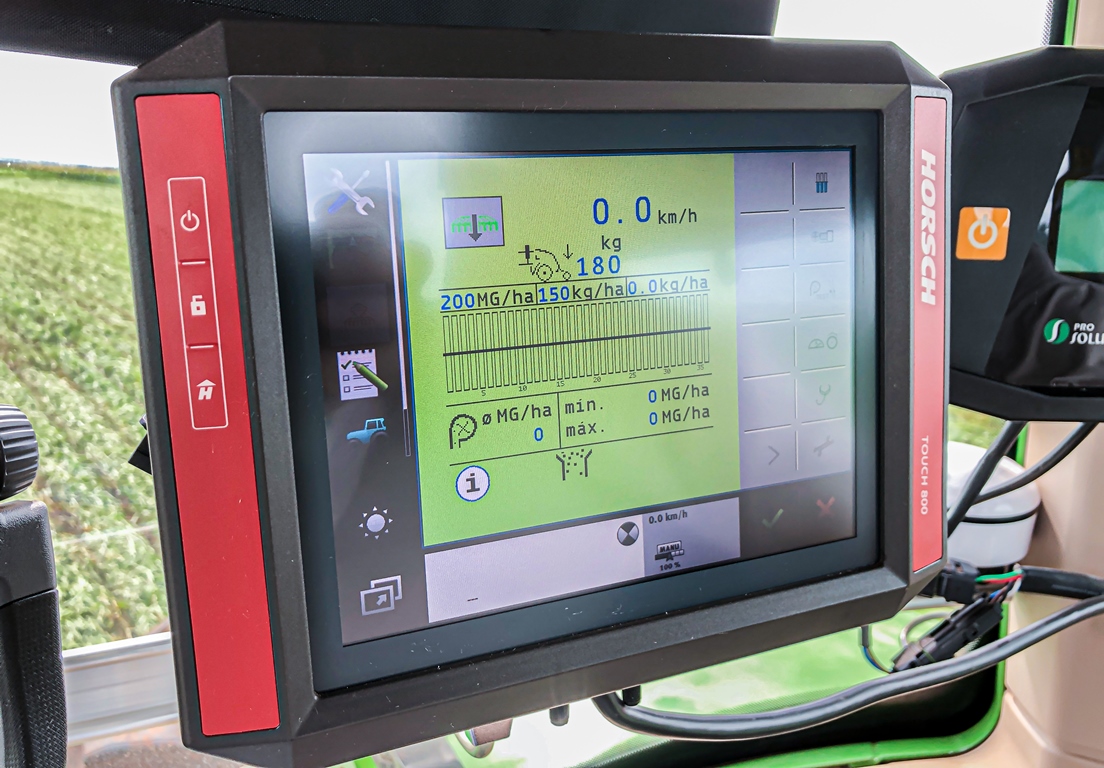
During the test, the visualization of the articulation capacity of the lines was remarkable, due to the irregularity of the terrain and the possibility of changing the pressure of the boom sections, from inside the cabin using the standard Isobus monitor, on touch. By the way, it is very important to highlight that the HORSCH Touch 800 monitor is fully Isobus standardized. Very interactive, it offers a lot of information that can be configured by the customer, according to their needs. It is also important to mention that HORSCH opens up the possibility for the customer to use the tractor's brand monitor, informing this detail at the time of purchase, simply by purchasing activation. This reduces the number of monitors within the operating environment.
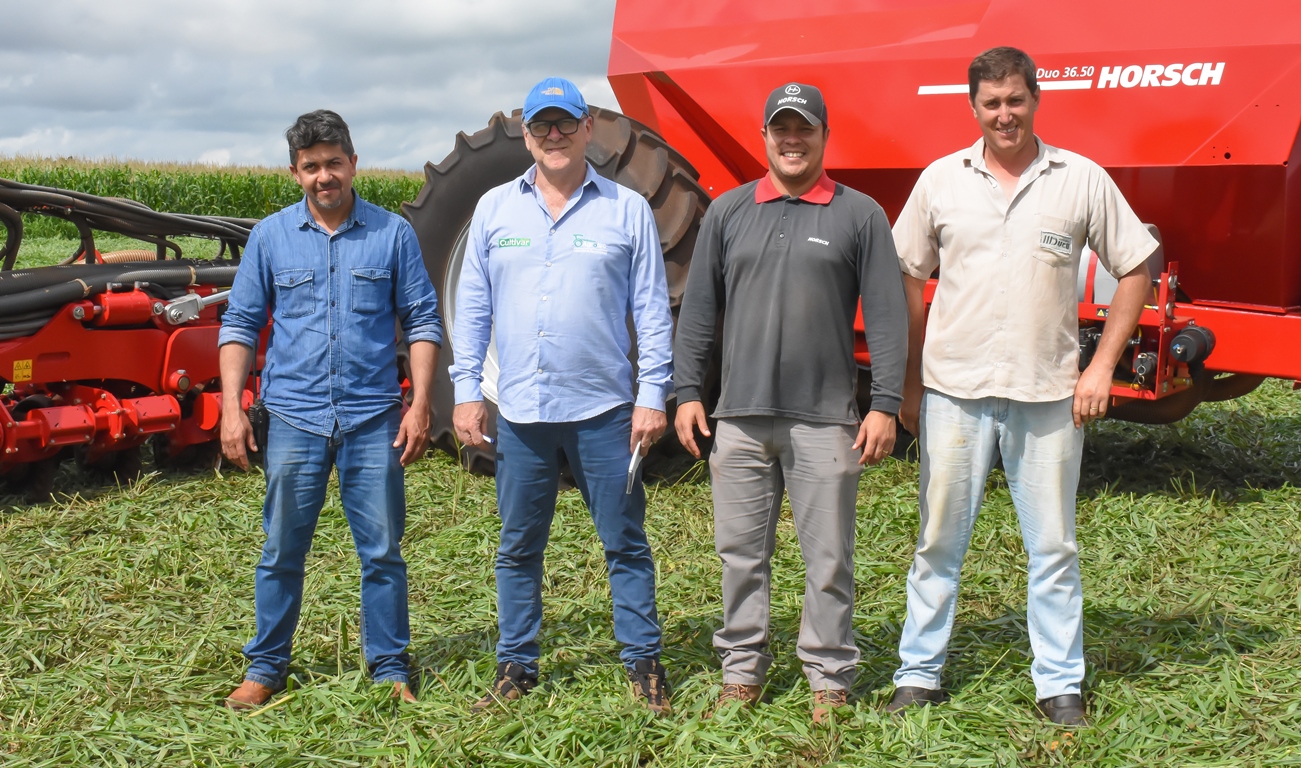
Already seen on the Maestro Evolution, the Duo model also comes equipped with a seeding simulator, which allows you to simulate seeding and fertilization with the machine stopped, by simply setting the operating speed. This allows the flow of seed and fertilizer to be checked, being decisive requirements in establishing the sowing density and the dose of fertilizer applied.
José Fernando Schlosser and
Daniela Herzog,
Agrotechnology Laboratory of the Agricultural Machinery Testing Center – UFSM
Alexandre Russini,
Federal University of Pampa - Unipampa

Receive the latest agriculture news by email